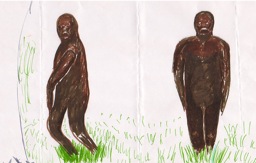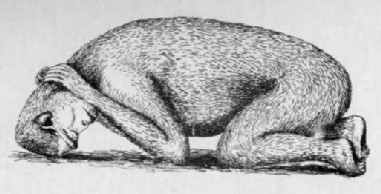
December 8, 2006
Why do some unknown hominoids have bare knees?

Wooden representation of a Proto-Pygmy from Africa.

Witness drawing of a Yowie from Australia.
In 1913, Muscovite V. A. Khakhlov submitted to the Russian Imperial Academy of Sciences his extraordinarily detailed report about the unknown hairy hominids of eastern Asia. In one section of the document, Khakhlov gathered reports from the native Kazakhs of Dzungaria.
Dzungaria is named after a Mongolian kingdom which existed in Central Asia during the seventeenth and eighteenth centuries. Today, Dzungaria is a geographical region within the Xinjiang Uygur Autonomous Region, northwestern China. The area is a largely steppe and semidesert basin surrounded by high mountains: the Tian Shan in the south and the Altai in the north. Outside of Asia, the name is mostly associated with Dzungarian hamsters (Phodopus campbelli or Phodopus sungorus, depending on your source).
Specifically, Khakhlov wrote an interesting passage which appears to explain, perhaps, what is found regarding the “bare knees.” Khakhlov noted the following, in his report (as recorded by Ivan T. Sanderson in Abominable Snowmen: Legend Come to Life), of one captive “wild woman” (an Almas) in the region of the River Manass, or Dam:
This creature seldom issued any sounds and usually was quiet and silent. Only when approached she bared her teeth and screeched. It [sic] has a peculiar way of lying down, or sleeping – like a camel, by squatting on the ground on its knees and elbows, resting the forehead on the ground, and resting the head [see drawing below from his report]. This position accounts for the unusually hard skin of the elbows and knees – like camel’s soles.
Could this be the reason for reports of bare knees? Could this aspect of certain representations of hairy hominoids be why this special trait is shown, due to shared behavior in using this sleeping position?

Sleeping position of an Almas from Asia.
About Loren Coleman
Loren Coleman is one of the world’s leading cryptozoologists, some say “the” leading living cryptozoologist. Certainly, he is acknowledged as the current living American researcher and writer who has most popularized cryptozoology in the late 20th and early 21st centuries.
Starting his fieldwork and investigations in 1960, after traveling and trekking extensively in pursuit of cryptozoological mysteries, Coleman began writing to share his experiences in 1969. An honorary member of Ivan T. Sanderson’s Society for the Investigation of the Unexplained in the 1970s, Coleman has been bestowed with similar honorary memberships of the North Idaho College Cryptozoology Club in 1983, and in subsequent years, that of the British Columbia Scientific Cryptozoology Club, CryptoSafari International, and other international organizations. He was also a Life Member and Benefactor of the International Society of Cryptozoology (now-defunct).
Loren Coleman’s daily blog, as a member of the Cryptomundo Team, served as an ongoing avenue of communication for the ever-growing body of cryptozoo news from 2005 through 2013. He returned as an infrequent contributor beginning Halloween week of 2015.
Coleman is the founder in 2003, and current director of the International Cryptozoology Museum in Portland, Maine.
Filed under Abominable Snowman, Almas, Breaking News, Cryptomundo Exclusive, Cryptotourism, CryptoZoo News, Cryptozoologists, Cryptozoology, Eyewitness Accounts, Folklore, Homo floresiensis